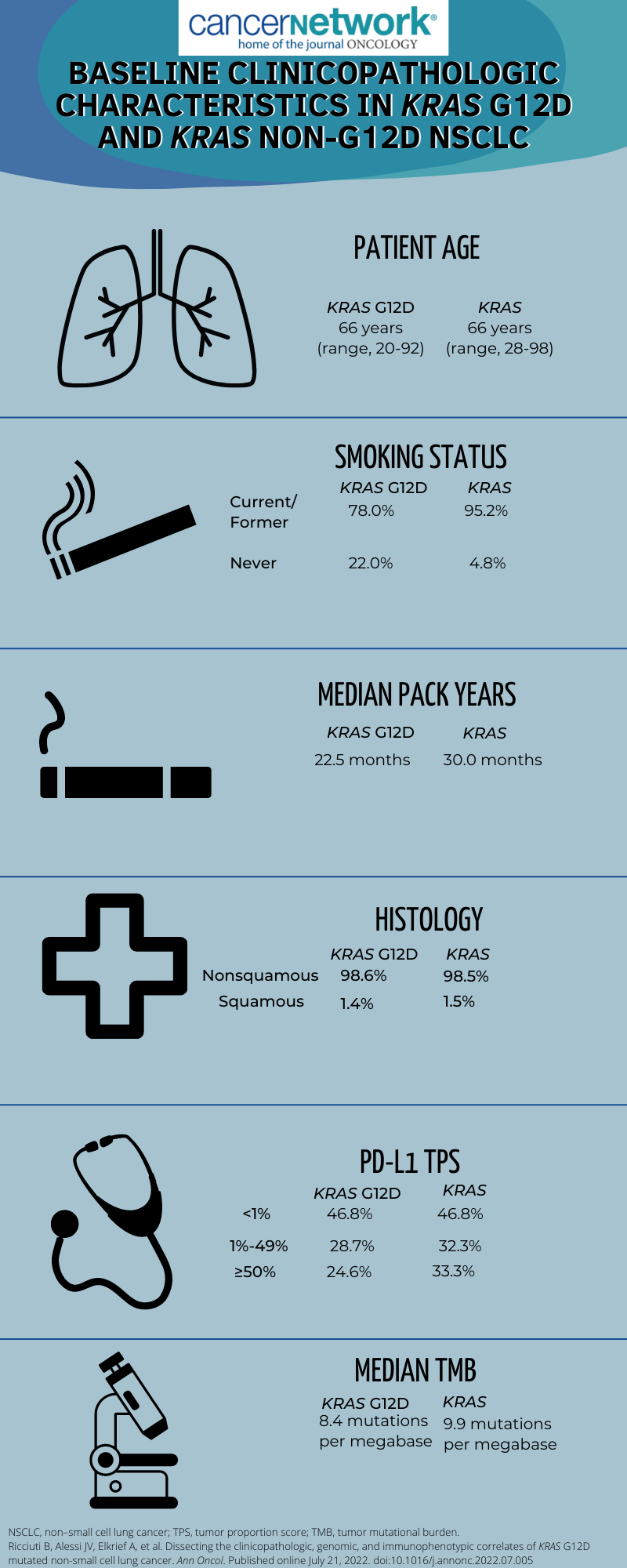KRAS G12D+ NSCLC Demonstrates Unique Features, Worse Outcomes Following PD-L1 Agents Vs Other KRAS Mutations
Distinct clinical, genomic, and immunologic features were observed among patients with KRAS G12D–positive non–small cell lung compared with those with other types of KRAS positivity.
Patients diagnosed with KRAS G12D–mutant non–small cell lung cancer (NSCLC) appear to have distinct clinical, genomic, and immunologic features and worse outcomes to treatment with anti–PD-L1 agents vs those with KRAS-mutant disease, according to findings from a study published in Annals of Oncology.
The KRAS G12D–positive group were noted as having as having lower PD-L1 proportion scores compared with patients harboring other KRAS mutations (median, 1% vs 5%; P <.01) and lower tumor mutational burden (median, 8.4 vs 9.9 mutations/Megabase; P <.0001). The KRAS G12D–positive population also had lower intratumoral and total CD8-positive, PD-1–positive cells (P <.05).
In patients with advanced NSCLC harboring KRAS mutations who were treated with PD-(L)1–based regimens (n = 850), monotherapy in the presence of KRAS G12D vs other KRAS mutations was associated with a worse objective response rate (ORR; 15.8% vs 28.4%; P = .03), progression-free survival (PFS; HR, 1.51; 95% CI, 1.45-2.00; P = .003), and overall survival (OS; HR, 1.45; 95% CI, 1.05-1.99; P = .02). However, the same was not observed for chemoimmunotherapy combinations in the KRAS G12D and other mutations groups, respectively, for ORR (30.6% vs 35.7%; P = .51), PFS (HR, 1.28; 95% CI, 0.92-1.77; P = .13), and OS (HR, 1.36; 95% CI, 0.95-1.96; P = .09).
Data were pulled from several institutions, including the Dana-Farber Cancer Institute (n = 1982), Memorial Sloan Kettering Cancer Center (n = 232), The University of Texas MD Anderson Cancer Center (n = 58), and National Health Service Trust (n = 55). Patients with cancer of extrathoracic origin were excluded from the study.
“[KRAS-mutated] NSCLC has heterogenous outcomes and should be considered in the context of the specific amino acid change and potential co-existing tumor suppressor mutations. Clinicopathologic analysis of [KRAS G12D–positive] NSCLC is timely given emerging allele-specific inhibitors targeting this subtype. Our analysis of [KRAS G12D–positive] NSCLC is the first and largest report characterizing this specific subset of lung cancers,” the investigators wrote.
A total of 2327 patients were identified who had oncogenic KRAS mutations. Patients had a median age of 66 years and 65% were women. Most patients (99%) had nonsquamous histology. Pack-year smoking data were collected in 1993 out of 2327 patients, of whom 15% had a smoking history of less than 10 pack-years and 55% had a history of 30 or more pack-years.
Baseline Clinicopathologic Characteristics in KRAS G12D and KRAS non-G12D NSCLC

Fifteen percent of patients with a KRAS mutations fell in the KRAS G12D subgroup. Several other KRAS drivers, included G12C (42%), G12V (19%), G12A (7%), G13X (6%), and Q61X (6%), were reported. Investigators indicated that those in the KRAS G12D group compared with non–KRAS G12D groups were more likely to be never smokers (22% vs 5%; P <.0001) and have less tobacco use history (median, 22.5 vs 30.0 pack years; P <.0001).
In the original cohort of patients, 1408 individuals received large panel next-generation sequencing conducted on their tumor samples. In total, 30% of patients had stage I disease, 26% with stage II or III, and 44% with stage IV. The most frequently observed mutations in the overall population were TP53 (39%), STK11 (21%), CDKN2A (11%), ATM (9%), RBM10 (8%), and KEAP1 (7%). In particular, the most common co-mutations in the KRAS G12D population were TP53 (32%), CDKN2A (15%), STK11 (13%0, NKX2-1(10%), and RBM10 (6%). The population was found to be significantly enriched with mutations impacting NKX2-1 and CDKN2A compared with the non–KRAS G12D arm.
Moreover, when assessing difference in immunophenotype between the 2 groups, investigators reported that the KRAS G12D group had significantly less CD8-positive T cells in the tumor-stromal interface (median, 244 vs 458 cells/mm2; P = .04) and overall (median, 165 vs 276 cells/mm2; P = .01), as well as intratumoral (median, 11 vs 23 cells/mm2; P = .02) and total CD8-positive, PD-1–positive T cells (median, 11 vs 23 cells/mm2; P = .02).
Reference
Ricciuti B, Alessi JV, Elkrief A, et al. Dissecting the clinicopathologic, genomic, and immunophenotypic correlates of KRASG12D mutated non-small cell lung cancer. Ann Oncol. Published online July 21, 2022. doi:10.1016/j.annonc.2022.07.005